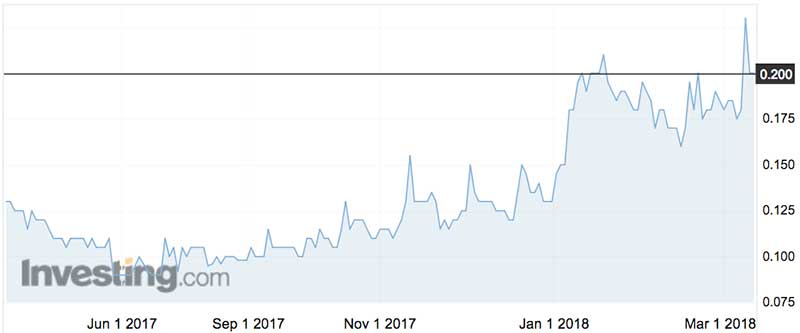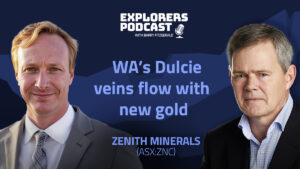Here’s why Zenith Minerals shares have doubled in the past year

Pic: John W Banagan / Stone via Getty Images
In an ideal world, the perfect battery-metals exploration company would have a combination of cobalt and lithium in the same prospect.
While that may sound far-fetched, it’s one of the reasons why Zenith Minerals shares have doubled since late last year.
The rise from 11c to recent trades at 22c can be traced, in part, to interest in one of Zenith’s diverse portfolio of interests scattered around the world — the Split Rocks lithium-gold-cobalt project near the south coast of WA.
Limited recent work has been carried out by Zenith (ASX:ZNC) at Split Rocks — but a review of past drill results has revealed encouraging cobalt assays from an area just 10km from the big Earl Grey lithium-rich pegmatite that sent Kidman resources from 10c to $2.20.
Location, or near-ology, can be a powerful force in the business of mineral exploration — as can having friends in high places, which is another aspect of Zenith that has been overlooked.
Exactly 12 months ago, without generating much interest, Zenith struck a deal on lithium prospects it has in the US and Mexico with one of Britain’s most active investors, billionaire financier Jim Mellon.
That deal with one of Mellon’s companies, Bradda Head Ltd, is moving towards a major development that should see it listed soon on the London Stock Exchange. Zenith will retain an ongoing interest in the joint-ventured lithium assets.

The close relationship with Mellon’s group of companies was highlighted last week when Zenith’s chief executive, Mike Joyce, delivered a presentation in London at the Master Investor Conference, an event closely associated with Mellon.
For investors developing an interest in the mineral exploration sector Zenith is an example of how the business works, starting with a policy of being in the right commodity at the right time, and then spreading out to secure a foothold in a number of prospects in a number of locations.
Floated in 2007 as the Zinc Company of Australia, a name change in 2010 saw it re-emerge as Zenith followed by a hunt for assets that could be monetised. It ended up with exploration projects including lithium in North America, gold in Turkey, copper and zinc in Queensland, and manganese and iron ore in WA.
Focus on battery metals
The assets at the top of Zenith’s pile that are generating the most interest today are in the battery metals sector, which is what Joyce focused on in his London presentation.
More will be heard later this year about work at the international lithium projects. Meanwhile the key to local interest will be Split Rocks, thanks to a combination of high prices for lithium and cobalt and the fact that both minerals have been identified in the same location.
- Bookmark this link for small cap breaking news
- Discuss small cap news in our Facebook group
- Follow us on Facebook or Twitter
- Subscribe to our daily newsletter
The assessment process at Split Rock, so far, involves re-visiting old drill core and exploration results reported to the WA Mines Department by previous explorers in the area and available under an “open file” policy which means each generation of explorers get to see what earlier prospectors found – or didn’t find.
In the case of Split Rocks most of the early work was focused on gold. So when drilling at the Dulcie prospect in 1998 returned encouraging cobalt and nickel assays from a clay-like material called saprolite, no-one paid much attention.
Prices at the time explain why Dulcie and the surrounding area was of no interest.
Nickel in 1998 had crashed back to around $2 a pound but is now more than $US6/lb. Cobalt has done even better soaring from around $US20,000 a tonne to almost $US90,000/t today – and probably heading higher as a stampede develops among electric car makers for the rare metal.
Historic drill results
Zenith, which has essentially been rummaging through Mines Department records, has found drill results from Dulcie that include 22 metres of core assaying 0.06% cobalt and 0.7% nickel from a depth of 18m, with a richer section grading 0.12% cobalt and 0.96% nickel over 8m.
Very limited drilling was conducted in the early years on what might now be seen as a cobalt/nickel target with indications of cobalt in all directions, but never examined in detail even though the first significant cobalt assays were noted as far back as 1974 by the US miner, Kennecott.
But wait, there’s more.
Also located on the Split Rocks tenement are three large-scale lithium targets outlined by surface geochemical surveys which Zenith said in its December quarterly report showed signs of “comparable surface results” obtained by competitors who later drilled and found “significant bedrock lithium mineralisation” – perhaps a way of mentioning Early Grey without naming Kidman’s discovery.
The year ahead promises to be one of the busiest for Zenith. Drill permits to test the lithium targets at Split Rocks have been received and Bradda Head will be actively looking for commercial deposits of lithium in the U.S. and Mexico.
A decade of obscurity could soon give way to a position of exploration prominence for Zenith.
Work on the U.S. and Mexican lithium projects is being funded through the joint venture with Bradda Head and is likely to accelerate later this year after the British company finalises its stock exchange listing.
In Australia, the focus will be on the Split Rocks project, thanks largely to its rare combination of cobalt and lithium in the one package, albeit in different types of rocks found on a 500 square kilometre tenement.
UNLOCK INSIGHTS
Discover the untold stories of emerging ASX stocks.
Daily news and expert analysis, it's free to subscribe.
By proceeding, you confirm you understand that we handle personal information in accordance with our Privacy Policy.








